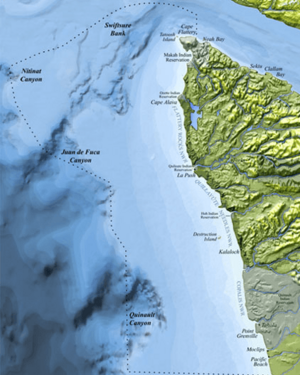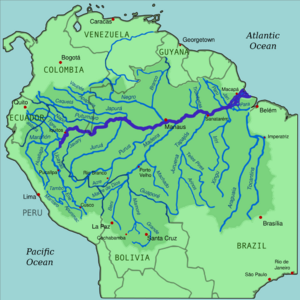Juan de Fuca Channel facts for kids

The Juan de Fuca Channel is a special underwater valley, also called a submarine channel. It's located off the coast of Washington state in the United States, near the Strait of Juan de Fuca. Think of it like a deep riverbed, but under the ocean!
Contents
What is the Juan de Fuca Channel Like?
The Juan de Fuca Channel is a deep underwater canyon that starts where the continental shelf ends, near southern Vancouver Island. It then stretches all the way to the Strait of Juan de Fuca. This canyon is quite narrow but very deep, with steep sides.
Imagine looking at a cross-section of it:
- It's about 6-kilometre (3.7 mi) wide at the top.
- It drops from 200 metres (660 ft) deep to more than 500 metres (1,600 ft) deep at its lowest point, called the thalweg.
This amazing underwater canyon is about 350-kilometre (220 mi) long and has two main parts:
- The upper canyon is narrow and goes southwest down the continental slope. It's carved into solid rock and drops about 17 metres per kilometre (90 ft/mi) for every kilometer.
- The lower channel goes northwest, running alongside the edge of the continental shelf. It's not as steep, dropping only about 7 metres per kilometre (37 ft/mi). This part ends at a feature called the Nitinat fan, which is like a small underwater fan-shaped deposit of sediment.
Unlike most other underwater canyons in the area, the Juan de Fuca Channel cuts right through the continental shelf and continues into the Strait of Juan de Fuca.
How Much Water Flows Through the Channel?

The Juan de Fuca Channel connects to the Strait of Juan de Fuca, which is the waterway separating the United States and Canada. This canyon is nearly 4 miles (6.4 km) wide and at least 450 yards (410 m) deep. That's twice as deep as the surrounding seafloor!
For many years, scientists have known that a massive amount of deep ocean water flows into Puget Sound. This flow is truly enormous – it's like 20 to 30 times more water than all the rivers on Earth combined, including the mighty Amazon River! And here's the surprising part: this water flows towards the land, not away from it.
Recent measurements (from 2017) show that the Juan de Fuca Channel might be the main pathway for most of this water. It brings water into Puget Sound, the Strait of Juan de Fuca, and even Canada's Strait of Georgia. The way water moves here is like a two-layer system: a dense lower layer of ocean water flows inland, while the upper layer flows out to sea.
Why is This Channel So Important?
The Juan de Fuca Channel acts like a special pathway, bringing deep water from the Pacific Ocean into the Salish Sea.
Life in the Channel
Puget Sound is famous for its rich marine life. The Juan de Fuca Channel plays a big part in this! It pulls water full of important nutrients from the deep ocean.
New measurements (from 2017) help explain why this canyon helps the Pacific Northwest's inland waters support so many amazing creatures, like shellfish, salmon runs, and even pods of whales.
Water rushes up the channel and mixes at incredibly fast rates. This strong flow and mixing inside the Juan de Fuca Channel might explain why the shores of Washington are so productive. Normally, coastal winds bring in some nutrients, but they don't fully explain the richness. Matthew Alford, an oceanographer, says, "Washington is several times more productive – has more phytoplankton – than Oregon or California, and yet the winds here are several times weaker. That’s been kind of a puzzle, for years."
About 150 metres (500 ft) below the surface, water has been measured flowing as fast as 0.40 metres per second (1.3 ft/s)! This causes mixing that is up to 1,000 times faster than normal in the deep ocean. The water flows smoothly over a shallow ridge near Cape Flattery. Then, on the other side, it creates a turbulent, breaking undersea wave, mixing with the surface water far above.
The deep water pushed up through the channel is full of nutrients. These nutrients help marine plants grow, which then become food for other marine life. This deep water is also a bit more acidic and has less oxygen, which affects the water conditions in the Strait of Juan de Fuca.
Fishing in the Juan de Fuca Canyon
Because of the strong currents and rich nutrients, the Juan de Fuca Canyon is a great spot for fishing. Matthew Alford, the oceanographer, notes, "The location of this sill would be an outstanding place to fish. People fish in Juan de Fuca Canyon pretty actively, and that’s probably no coincidence."

